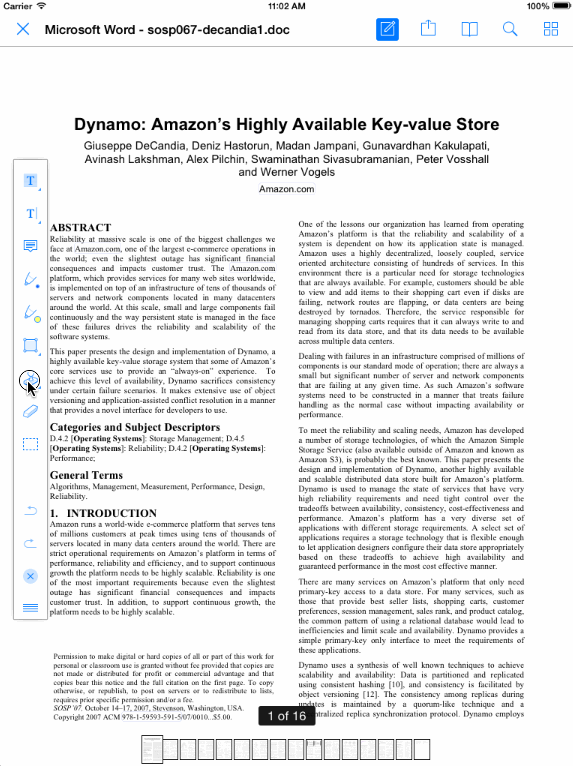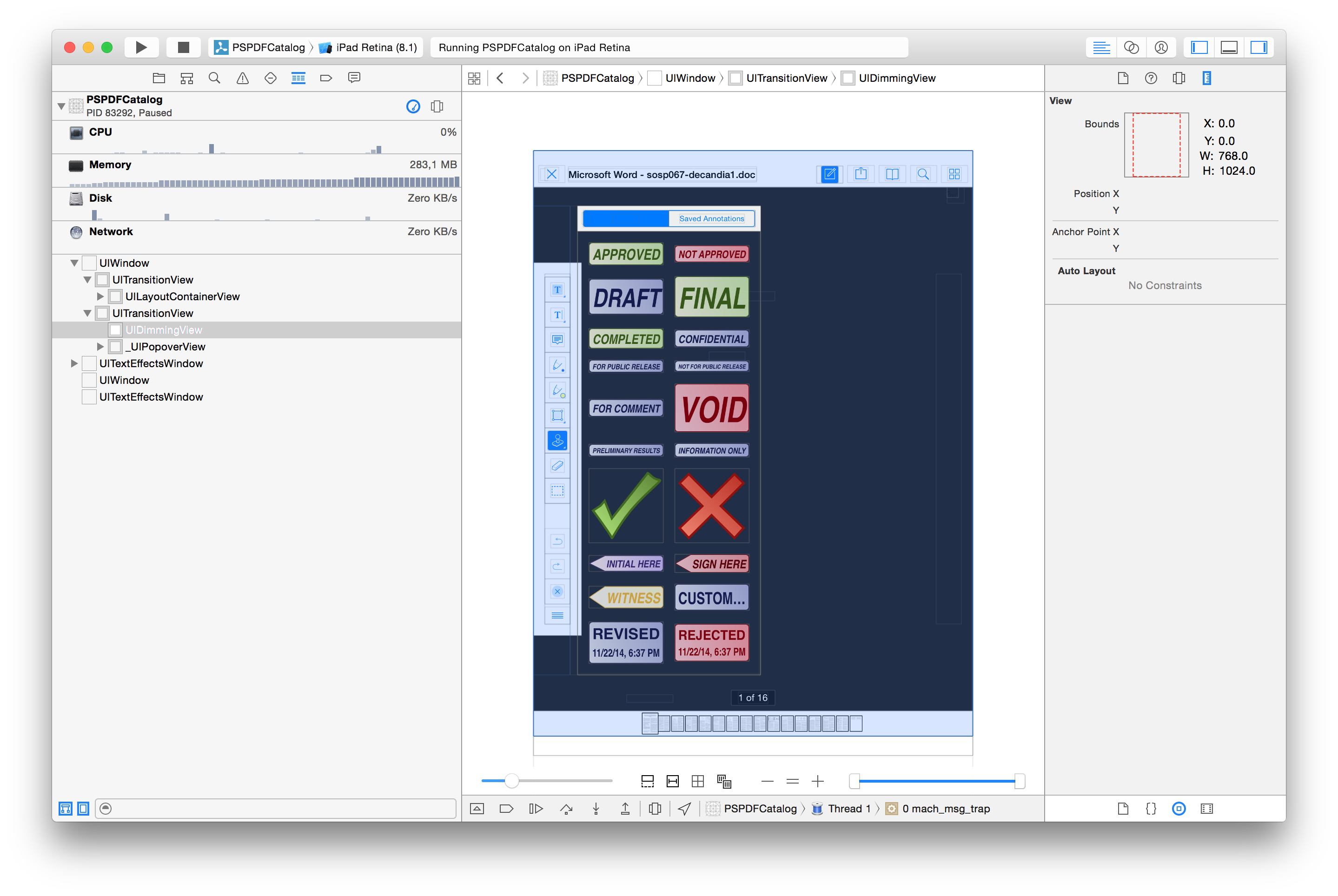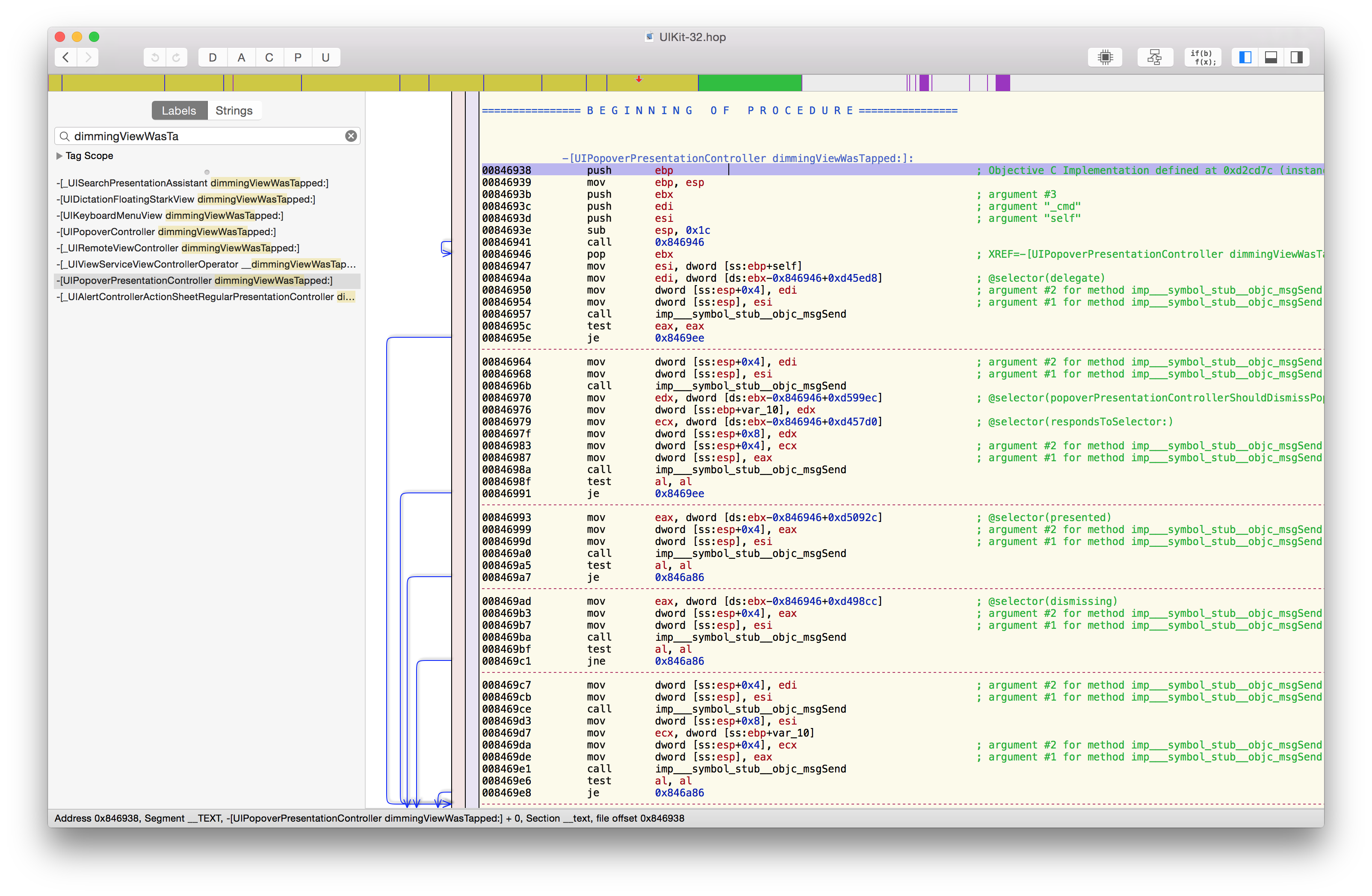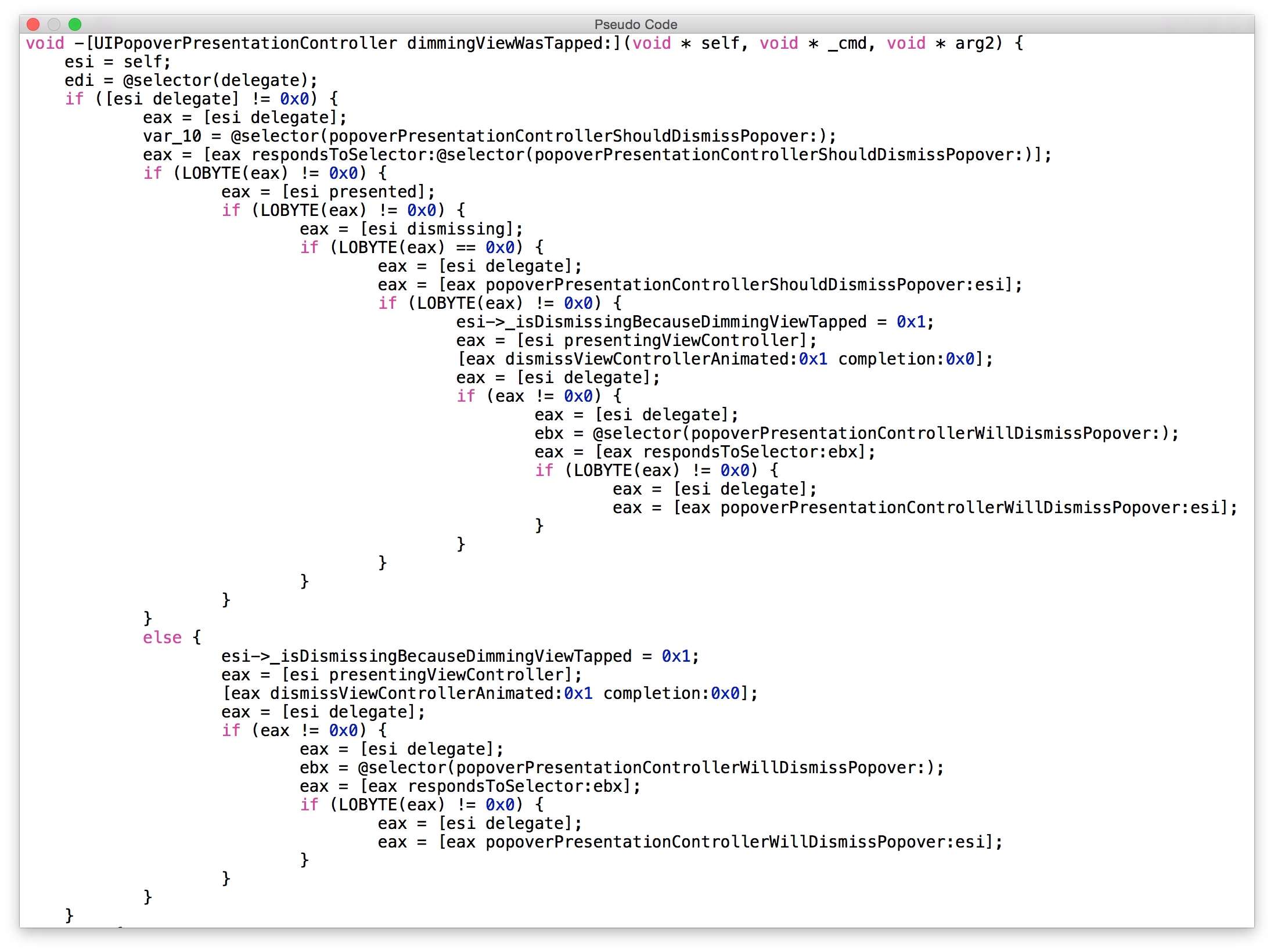Nobody writes perfect code, and debugging is something every one of us should be able to do well. Instead of providing a random list of tips about the topic, I'll walk you through a bug that turned out to be a regression in UIKit, and show you the workflow I used to understand, isolate, and ultimately work around the issue.
The Issue
We received a bug report where quickly tapping on a button that presented a popover dismissed the popover but also the parent view controller. Thankfully, a sample was included, so the first part — of reproducing the bug — was already taken care of:

My first guess was that we might have code that dismisses the view controller, and we wrongfully dismiss the parent. However, when using Xcode's integrated view debugging feature, it was clear that there was a global UIDimmingView that was the first responder for touch input:

Apple added the Debug View Hierarchy feature in Xcode 6, and it's likely that this move was inspired by the popular Reveal and Spark Inspector apps, which, in many ways, are still better and more feature rich than the Xcode feature.
Using LLDB
Before there was visual debugging, the common way to inspect the hierarchy was using po [[UIWindow keyWindow] recursiveDescription] in LLDB, which prints out the whole view hierarchy in text form.
Similar to inspecting the view hierarchy, we can also inspect the view controller hierarchy using po [[[UIWindow keyWindow] rootViewController] _printHierarchy]. This is a private helper on UIViewController that Apple silently added in iOS 8:
(lldb) po [[[UIWindow keyWindow] rootViewController] _printHierarchy]
<PSPDFNavigationController 0x7d025000>, state: disappeared, view: <UILayoutContainerView 0x7b3218d0> not in the window
| <PSCatalogViewController 0x7b3100d0>, state: disappeared, view: <UITableView 0x7c878800> not in the window
+ <UINavigationController 0x8012c5d0>, state: appeared, view: <UILayoutContainerView 0x8012b7a0>, presented with: <_UIFullscreenPresentationController 0x80116c00>
| | <PSPDFViewController 0x7d05ae00>, state: appeared, view: <PSPDFViewControllerView 0x80129640>
| | | <PSPDFContinuousScrollViewController 0x7defa8e0>, state: appeared, view: <UIView 0x7def1ce0>
| + <PSPDFNavigationController 0x7d21a800>, state: appeared, view: <UILayoutContainerView 0x8017b490>, presented with: <UIPopoverPresentationController 0x7f598c60>
| | | <PSPDFContainerViewController 0x8017ac40>, state: appeared, view: <UIView 0x7f5a1380>
| | | | <PSPDFStampViewController 0x8016b6e0>, state: appeared, view: <UIView 0x7f3dbb90>
LLDB is quite powerful and can also be scripted. Facebook released a collection of python scripts named Chisel that help a lot with daily debugging. pviews and pvc are the equivalents for view and view controller hierarchy printing. Chisel's view controller tree is similar, but also displays the view rects. I often use it to inspect the responder chain, and while you could manually loop over nextResponder on the object you're interested in, or add a category helper, typing presponder object is by far the quickest way.
Adding Breakpoints
Let's first figure out what code is actually dismissing our view controller. The most obvious action is setting a breakpoint on viewWillDisappear: to see the stack trace:
(lldb) bt
* thread #1: tid = 0x1039b3, 0x004fab75 PSPDFCatalog`-[PSPDFViewController viewWillDisappear:](self=0x7f354400, _cmd=0x03b817bf, animated='\x01') + 85 at PSPDFViewController.m:359, queue = 'com.apple.main-thread', stop reason = breakpoint 1.1
* frame #0: 0x004fab75 PSPDFCatalog`-[PSPDFViewController viewWillDisappear:](self=0x7f354400, _cmd=0x03b817bf, animated='\x01') + 85 at PSPDFViewController.m:359
frame #1: 0x033ac782 UIKit`-[UIViewController _setViewAppearState:isAnimating:] + 706
frame #2: 0x033acdf4 UIKit`-[UIViewController __viewWillDisappear:] + 106
frame #3: 0x033d9a62 UIKit`-[UINavigationController viewWillDisappear:] + 115
frame #4: 0x033ac782 UIKit`-[UIViewController _setViewAppearState:isAnimating:] + 706
frame #5: 0x033acdf4 UIKit`-[UIViewController __viewWillDisappear:] + 106
frame #6: 0x033c46a1 UIKit`-[UIViewController(UIContainerViewControllerProtectedMethods) beginAppearanceTransition:animated:] + 200
frame #7: 0x03380ad8 UIKit`__56-[UIPresentationController runTransitionForCurrentState]_block_invoke + 594
frame #8: 0x033b47ab UIKit`__40+[UIViewController _scheduleTransition:]_block_invoke + 18
frame #9: 0x0327a0ce UIKit`___afterCACommitHandler_block_invoke + 15
frame #10: 0x0327a079 UIKit`_applyBlockToCFArrayCopiedToStack + 415
frame #11: 0x03279e8e UIKit`_afterCACommitHandler + 545
frame #12: 0x060669de CoreFoundation`__CFRUNLOOP_IS_CALLING_OUT_TO_AN_OBSERVER_CALLBACK_FUNCTION__ + 30
frame #20: 0x032508b6 UIKit`UIApplicationMain + 1526
frame #21: 0x000a119d PSPDFCatalog`main(argc=1, argv=0xbffcd65c) + 141 at main.m:15
(lldb)
With LLDB's bt command, you can print the backtrace. bt all will do the same, but it prints the state of all threads, and not just the current one.
Looking at the stack trace, we notice that the view controller is already dismissing, as we're called from a scheduled animation, so we need to add a breakpoint earlier. In this case, we are interested in calls to -[UIViewController dismissViewControllerAnimated:completion:]. We add a symbolic breakpoint to Xcode's breakpoint list and run the sample again.
The Xcode breakpoint interface is very powerful, allowing you to add conditions, skip counts, or even custom actions like playing a sound effect and automatically continuing. We don't need these features here, but they can save quite a bit of time:
(lldb) bt
* thread #1: tid = 0x1039b3, 0x033bb685 UIKit`-[UIViewController dismissViewControllerAnimated:completion:], queue = 'com.apple.main-thread', stop reason = breakpoint 7.1
* frame #0: 0x033bb685 UIKit`-[UIViewController dismissViewControllerAnimated:completion:]
frame #1: 0x03a7da2c UIKit`-[UIPopoverPresentationController dimmingViewWasTapped:] + 244
frame #2: 0x036153ed UIKit`-[UIDimmingView handleSingleTap:] + 118
frame #3: 0x03691287 UIKit`_UIGestureRecognizerSendActions + 327
frame #4: 0x0368fb04 UIKit`-[UIGestureRecognizer _updateGestureWithEvent:buttonEvent:] + 561
frame #5: 0x03691b4d UIKit`-[UIGestureRecognizer _delayedUpdateGesture] + 60
frame #6: 0x036954ca UIKit`___UIGestureRecognizerUpdate_block_invoke661 + 57
frame #7: 0x0369538d UIKit`_UIGestureRecognizerRemoveObjectsFromArrayAndApplyBlocks + 317
frame #8: 0x03689296 UIKit`_UIGestureRecognizerUpdate + 3720
frame #9: 0x032a226b UIKit`-[UIWindow _sendGesturesForEvent:] + 1356
frame #10: 0x032a30cf UIKit`-[UIWindow sendEvent:] + 769
frame #21: 0x032508b6 UIKit`UIApplicationMain + 1526
frame #22: 0x000a119d PSPDFCatalog`main(argc=1, argv=0xbffcd65c) + 141 at main.m:15
Now we're talking! As expected, the fullscreen UIDimmingView receives our touch and processes it in handleSingleTap:, then forwarding it to UIPopoverPresentationController's dimmingViewWasTapped:, which dismisses the controller (as it should). However, when we tap quickly, this breakpoint is called twice. Is there a second dimming view? Is it called on the same instance? We only have the assembly on this breakpoint, so calling po self will not work.
Calling Conventions 101
With some basic knowledge of assembly and function-calling conventions, we can still get the value of self. The iOS ABI Function Call Guide and the Mac OS X ABI Function Call Guide that is used in the iOS Simulator are both great resources.
We know that every Objective-C method has two implicit parameters: self and _cmd. So what we need is the first object on the stack. For the 32-bit architecture, the stack is saved in $esp, so you can use po *(int*)($esp+4) to get self, and p (SEL)*(int*)($esp+8) to get _cmd in Objective-C methods. The first value in $esp is the return address. Subsequent variables are in $esp+12, $esp+16, and so on.
The x86-64 architecture (iPhone Simulator for devices that have an arm64 chip) offers many more registers, so variables are placed in $rdi, $rsi, $rdx, $rcx, $r8, $r9. All subsequent variables land on the stack in $rbp, starting with $rbp+16, $rbp+24, etc.
The armv7 architecture generally places variables in $r0, $r1, $r2, $r3, and then moves the rest on the stack $sp:
(lldb) po $r0
<PSPDFViewController: 0x15a1ca00 document:<PSPDFDocument 0x15616e70 UID:amazondynamososp2007_0c7fb1fc6c0841562b090b94f0c1c890 files:1 pageCount:16 isValid:1> page:0>
(lldb) p (SEL)$r1
(SEL) $1 = "dismissViewControllerAnimated:completion:"
Arm64 is similar to armv7, however, since there are more registers available, the whole range of $x0 to $x7 is used to pass over variables, before falling back to the stack register $sp.
You can learn more about stack layout for x86 and x86-64, and also by reading the AMD64 ABI Draft.
Using the Runtime
Another technique to track method execution is overriding the methods with a log statement before calling super. However, manually swizzling just to be able to debug more conveniently isn't really time efficient. A while back, I wrote a small library called Aspects that does exactly that. It can be used in production code, but I mostly use it for debugging and to write test cases. (If you're curious about Aspects, you can learn more here.)
#import "Aspects.h"
[UIPopoverPresentationController aspect_hookSelector:NSSelectorFromString(@"dimmingViewWasTapped:")
withOptions:0
usingBlock:^(id <AspectInfo> info, UIView *tappedView) {
NSLog(@"%@ dimmingViewWasTapped:%@", info.instance, tappedView);
} error:NULL];
This hooks into dimmingViewWasTapped:, which is private — thus we use NSSelectorFromString. You can verify that this method exists, and also look up all other private and public methods of pretty much every framework class, by using the iOS Runtime Headers. This project uses the fact that one can't really hide methods at runtime to query all classes and create a more complete header than what Apple gives us. (Of course, actually calling a private API is not a good idea — this is just to better understand what's going on.)
With the log message in the hooked method, we get the following output:
PSPDFCatalog[84049:1079574] <UIPopoverPresentationController: 0x7fd09f91c530> dimmingViewWasTapped:<UIDimmingView: 0x7fd09f92f800; frame = (0 0; 768 1024)>
PSPDFCatalog[84049:1079574] <UIPopoverPresentationController: 0x7fd09f91c530> dimmingViewWasTapped:<UIDimmingView: 0x7fd09f92f800; frame = (0 0; 768 1024)>
We see that the object address is the same, so our poor dimming view really is called twice. We can use Aspects again to see on which controller the dismiss is actually called:
[UIViewController aspect_hookSelector:@selector(dismissViewControllerAnimated:completion:)
withOptions:0
usingBlock:^(id <AspectInfo> info) {
NSLog(@"%@ dismissed.", info.instance);
} error:NULL];
2014-11-22 19:24:51.900 PSPDFCatalog[84210:1084883] <UINavigationController: 0x7fd673789da0> dismissed.
2014-11-22 19:24:52.209 PSPDFCatalog[84210:1084883] <UINavigationController: 0x7fd673789da0> dismissed.
Both times, the dimming view calls dismiss on our main navigation controller. UIViewControllers's dismissViewControllerAnimated:completion: will forward the view controller dismissal request to its immediate child controller, if there is one, otherwise it will dismiss itself. So the first time, the dismiss request goes to the popover, and the second time, the navigation controller itself gets dismissed.
Finding a Workaround
We now know what is happening — so let's move to the why. UIKit is closed source, but we can use a disassembler like Hopper to read the UIKit assembly and take a closer look what's going on in UIPopoverPresentationController. You'll find the binary under /Applications/Xcode.app/Contents/Developer/Platforms/iPhoneSimulator.platform/Developer/SDKs/iPhoneSimulator.sdk/System/Library/Frameworks/UIKit.framework. Use File -> Read Executable to Disassemble... and select this in Hopper, and watch how it crawls through the binary and symbolicates code. The 32-bit disassembler is the most mature one, so you'll get the best results selecting the 32-bit file slice. IDA by Hex-Rays is another very powerful and expensive disassembler, which often provides even better results:

Some basics in assembly are quite useful when reading through the code. However, you can also use the pseudo-code view to get something more C-like:

Reading the pseudo-code is quite eye-opening. There are two code paths — one if the delegate implements popoverPresentationControllerShouldDismissPopover:, and one if it doesn't — and the code paths are actually quite different. While the one reacting to the delegate basically has an if (controller.presented && !controller.dismissing), the other code path (that we currently fall into) doesn't, and always dismisses. With that inside knowledge, we can attempt to work around this bug by implementing our own UIPopoverPresentationControllerDelegate:
- (BOOL)popoverPresentationControllerShouldDismissPopover:(UIPopoverPresentationController *)popoverPresentationController {
return YES;
}
My first attempt was to set this to the main view controller that creates the popover. However, that broke UIPopoverController. While not documented, the popover controller sets itself as the delegate in _setupPresentationController, and taking the delegate away will break things. Instead, I used a UIPopoverController subclass and added the above method directly. The connection between these two classes is not documented, and our fix relies on this undocumented behavior; however, the implementation matches the default and exists purely to work around this issue, so it's future-proof code.
Reporting a Radar
Now please don't stop here. You should always properly document such workarounds, and most importantly, file a radar with Apple. As an additional benefit, this allows you to verify that you actually understood the bug, and that no other side effects from your application play a role — and if you drop an iOS version, it's easy to go back and test if the radar is still valid:
// The UIPopoverController is the default delegate for the UIPopoverPresentationController
// of it's contentViewController.
//
// There is a bug when someone double-taps on the dimming view, the presentation controller invokes
// dismissViewControllerAnimated:completion: twice, thus also potentially dismissing the parent controller.
//
// Simply implementing this delegate runs a different code path that properly checks for dismissing.
// rdar://problem/19067761
- (BOOL)popoverPresentationControllerShouldDismissPopover:(UIPopoverPresentationController *)popoverPresentationController {
return YES;
}
Writing radars is actually quite a fun challenge, and doesn't take as much time as you might think. With an example, you'll help out some overworked Apple engineer, and without it, the engineers will most likely push back and not even consider the radar. I managed to create a sample in about 50 LOC, including some comments and the workaround. The Single View Template is usually the quickest way to create an example.
Now, we all know that Apple's RadarWeb application isn't great, however, you don't have to use it. QuickRadar is a great Mac front-end that can submit the radar for you, and also automatically sends a copy to OpenRadar. Furthermore, it makes duping radars extremely convenient. You should download it right away and dupe rdar://19067761 if you feel like this bug should be fixed.
Not every issue can be solved with such a simple workaround, however, many of these steps will help you find better solutions to issues, or at least improve your understanding of why something is happening.
References
-
Aspects — Delightful, simple library for aspect-oriented programming.
-
Chisel — a collection of LLDB commands to assist debugging iOS apps